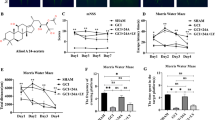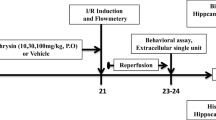Abstract
Increasing evidence demonstrates inflammation contributes to neuronal death following cerebral ischemia. Lycium barbarum polysaccharide (LBP) has been reported to prevent scopolamine-induced cognitive and memory deficits. We recently indicated that LBP exerts neuroprotective effect against focal cerebral ischemic injury in mice via attenuating the mitochondrial apoptosis pathway. The aim of this study was to investigate the neuroprotective effects of LBP against the behavioral dysfunction induced by focal cerebral ischemia injury in mice. Following 7 successive days of pretreatment with LBP (10, 20 and 40 mg/kg) and nimodipine (4 mg/kg) by intragastric gavage, mice were subjected to middle cerebral artery occlusion (MCAO). Following reperfusion, cerebral blood flows, the total power of the spontaneous EEG, and morphological changes were estimated. Learning and memory ability, and motor coordination were determined by Morris water maze task, rotarod and grip test. Western blot analysis, Real-Time fluorogenic PCR assays, and immunofluorescence staining were used to examine the expression of proinflammatory mediators and activation of microglia. The present study showed that LBP pretreatment significantly enhanced regional cortical blood flow and the total power of the spontaneous EEG, improved memory and motor coordination impairments, and inhibited over-activation of microglia and astrocytes after MCAO. Further study demonstrated LBP suppressed MCAO-induced activations of P65 NF-κB and P38 MAPK, and prevented up-regulations of proinflammatory mediators in hippocampus. Our data suggest that LBP can exert functional recovery of memory and motor coordination deficits and neuroprotective effect against cerebral ischemic injury in mice.











Similar content being viewed by others
Abbreviations
- DAPI:
-
4′,6-diamidino-2-phenylindole
- ECL:
-
Enhanced chemiluminescence
- H&E:
-
Hematoxylin and eosin
- ICA:
-
Internal carotid artery
- ICR:
-
Institute of cancer research
- IL-1:
-
Interleukin 1
- IL-6:
-
Interleukin 6
- LBP:
-
Lycium barbarum polysaccharide
- LSCI:
-
Laser speckle contrast imaging
- MCA:
-
Middle cerebral artery
- MCAO:
-
Middle cerebral artery occlusion
- MWM:
-
Morris water maze
- Nim:
-
Nimodipine
- NO:
-
Nitric oxide
- rCBF:
-
Regional cortical blood flow
- ROS:
-
Reactive oxygen species
- SDS-PAGE:
-
Sodium dodecyl sulfate-polyacrylamide gel electrophoresis
- TBST:
-
Tris-buffered saline/tween-20
- TEM:
-
Transmission electron microscopy
- TNF-a:
-
Tumor necrosis factor-a
- TTC:
-
2,3,5-Triphenyl tetrazolium chloride
References
He J, Gu D, Wu X, Reynolds K, Duan X, Yao C, Wang J, Chen CS, Chen J, Wildman RP, Klag MJ, Whelton PK (2005) Major causes of death among men and women in China. N Engl J Med 353:1124–1134
Yao Y, Chen L, Xiao J, Wang C, Jiang W, Zhang R, Hao J (2014) Chrysin protects against focal cerebral ischemia/reperfusion injury in mice through attenuation of oxidative stress and inflammation. Int J Mol Sci 15:20913–20926
Zola-Morgan S, Squire LR, Amaral DG (1986) Human amnesia and the medial temporal region: enduring memory impairment following a bilateral lesion limited to field CA1 of the hippocampus. J Neurosci 6:2950–2967
Pulsinelli WA, Brierley JB (1979) A new model of bilateral hemispheric ischemia in the unanesthetized rat. Stroke 10:267–272
Xuan AG, Chen Y, Long DH, Zhang M, Ji WD, Zhang WJ, Liu JH, Hong LP, He XS, Chen WL (2015) PPARalpha agonist fenofibrate ameliorates learning and memory deficits in rats following global cerebral ischemia. Mol Neurobiol 52:601–609
Ren C, Wang B, Li N, Jin K, Ji X (2015) Herbal formula danggui-shaoyao-san promotes neurogenesis and angiogenesis in rat following middle cerebral artery occlusion. Aging Dis 6:245–253
Liu H, Wei X, Kong L, Liu X, Cheng L, Yan S, Zhang X, Chen L (2015) NOD2 is involved in the inflammatory response after cerebral ischemia-reperfusion injury and triggers NADPH oxidase 2-derived reactive oxygen species. Int J Biol Sci 11:525–535
Lambertsen KL, Biber K, Finsen B (2012) Inflammatory cytokines in experimental and human stroke. J Cereb Blood Flow Metab 32:1677–1698
Li S, Wu C, Zhu L, Gao J, Fang J, Li D, Fu M, Liang R, Wang L, Cheng M, Yang H (2012) By improving regional cortical blood flow, attenuating mitochondrial dysfunction and sequential apoptosis galangin acts as a potential neuroprotective agent after acute ischemic stroke. Molecules 17:13403–13423
Zhang C, Teng F, Tu J, Zhang D (2014) Ultrasound-enhanced protective effect of tetramethylpyrazine against cerebral ischemia/reperfusion injury. PLoS ONE 9:e113673
Huyan T, Li Q, Yang H, Jin M-L, Zhang M-J, Ye L-J, Li J, Huang Q-S, Yin D-C (2014) Protective effect of polysaccharides on simulated microgravity-induced functional inhibition of human NK cells. Carbohydr Polym 101:819–827
Zhao R, Qiu B, Li Q, Zhang T, Zhao H, Chen Z, Cai Y, Ruan H, Ge W, Zheng X (2014) LBP-4a improves insulin resistance via translocation and activation of GLUT4 in OLETF rats. Food Funct 5:811–820
Xiao J, Zhu Y, Liu Y, Tipoe GL, Xing F, So KF (2014) Lycium barbarum polysaccharide attenuates alcoholic cellular injury through TXNIP-NLRP3 inflammasome pathway. Int J Biol Macromol 69:73–78
He M, Pan H, Chang RC, So KF, Brecha NC, Pu M (2014) Activation of the Nrf2/HO-1 antioxidant pathway contributes to the protective effects of Lycium barbarum polysaccharides in the rodent retina after ischemia-reperfusion-induced damage. PloS ONE 9:e84800
Liu Y, Lv J, Yang B, Liu F, Tian Z, Cai Y, Yang D, Ouyang J, Sun F, Shi Y, Xia P (2015) Lycium barbarum polysaccharide attenuates type II collagen-induced arthritis in mice. Int J Biol Macromol 78:318–323
Xiao J, Xing F, Huo J, Fung ML, Liong EC, Ching YP, Xu A, Chang RC, So KF, Tipoe GL (2014) Lycium barbarum polysaccharides therapeutically improve hepatic functions in non-alcoholic steatohepatitis rats and cellular steatosis model. Sci Rep 4:5587
Chen W, Cheng X, Chen J, Yi X, Nie D, Sun X, Qin J, Tian M, Jin G, Zhang X (2014) Lycium barbarum polysaccharides prevent memory and neurogenesis impairments in scopolamine-treated rats. PLoS ONE 9(2):e88076
Rui C, Yuxiang L, Yinju H, Qingluan Z, Yang W, Qipeng Z, Hao W, Lin M, Juan L, Chengjun Z, Yuanxu J, Yanrong W, Xiuying D, Wannian Z, Tao S, Jianqiang Y (2012) Protective effects of Lycium barbarum polysaccharide on neonatal rat primary cultured hippocampal neurons injured by oxygen-glucose deprivation and reperfusion. J Mol Histol 43:535–542
Wang T, Li Y, Wang Y, Zhou R, Ma L, Hao Y, Jin S, Du J, Zhao C, Sun T, Yu J (2014) Lycium barbarum polysaccharide prevents focal cerebral ischemic injury by inhibiting neuronal apoptosis in mice. PloS ONE 9:e90780
Zhao P, Zhou R, Zhu XY, Hao YJ, Li N, Wang J, Niu Y, Sun T, Li YX, Yu JQ (2015) Matrine attenuates focal cerebral ischemic injury by improving antioxidant activity and inhibiting apoptosis in mice. Int J Mol Med 36:633–644
Bederson JB, Pitts LH, Tsuji M, Nishimura MC, Davis RL, Bartkowski H (1986) Rat middle cerebral artery occlusion: evaluation of the model and development of a neurologic examination. Stroke 17:472–476
Ferrara A, El Bejaoui S, Seyen S, Tirelli E, Plumier JC (2009) The usefulness of operant conditioning procedures to assess long-lasting deficits following transient focal ischemia in mice. Behav Brain Res 205:525–534
Oyemitan IA, Olayera OA, Alabi A, Abass LA, Elusiyan CA, Oyedeji AO, Akanmu MA (2015) Psychoneuropharmacological activities and chemical composition of essential oil of fresh fruits of Piper guineense (Piperaceae) in mice. J Ethnopharmacol 166:240–249
Morris RG, Garrud P, Rawlins JN, O’Keefe J (1982) Place navigation impaired in rats with hippocampal lesions. Nature 297:681–683
Ma B, Li M, Nong H, Shi J, Liu G, Zhang J (2008) Protective effects of extract of Coeloglossum viride var. bracteatum on ischemia-induced neuronal death and cognitive impairment in rats. Behav Pharmacol 19:325–333
Hori N, Carpenter DO (1994) Functional and morphological changes induced by transient in vivo ischemia. Exp Neurol 129:279–289
Scheff SW, Price DA (2003) Synaptic pathology in Alzheimer’s disease: a review of ultrastructural studies. Neurobiol Aging 24:1029–1046
Ma M, Uekawa K, Hasegawa Y, Nakagawa T, Katayama T, Sueta D, Toyama K, Kataoka K, Koibuchi N, Kuratsu J, Kim-Mitsuyama S (2013) Pretreatment with rosuvastatin protects against focal cerebral ischemia/reperfusion injury in rats through attenuation of oxidative stress and inflammation. Brain Res 1519:87–94
Jin R, Yang G, Li G (2010) Inflammatory mechanisms in ischemic stroke: role of inflammatory cells. J Leukoc Biol 87:779–789
Feng X, Wu CY, Burton FH, Loh HH, Wei LN (2014) beta-arrestin protects neurons by mediating endogenous opioid arrest of inflammatory microglia. Cell Death Differ 21:397–406
Farina C, Aloisi F, Meinl E (2007) Astrocytes are active players in cerebral innate immunity. Trends Immunol 28:138–145
Tuttolomondo A, Di Raimondo D, di Sciacca R, Pinto A, Licata G (2008) Inflammatory cytokines in acute ischemic stroke. Curr Pharm Des 14:3574–3589
Zhu Y, Saito K, Murakami Y, Asano M, Iwakura Y, Seishima M (2006) Early increase in mRNA levels of pro-inflammatory cytokines and their interactions in the mouse hippocampus after transient global ischemia. Neurosci Lett 393:122–126
Minami M, Katayama T, Satoh M (2006) Brain cytokines and chemokines: roles in ischemic injury and pain. J Pharmacol Sci 100:461–470
Ridder DA, Schwaninger M (2009) NF-kappaB signaling in cerebral ischemia. Neuroscience 158:995–1006
Stephenson D, Yin T, Smalstig EB, Hsu MA, Panetta J, Little S, Clemens J (2000) Transcription factor nuclear factor-kappa B is activated in neurons after focal erebral Iichemia. J Cereb Blood Flow Metab 20:592–603
Zhang F, Li N, Jiang L, Chen L, Huang M (2015) Neuroprotective effects of (-)-epigallocatechin-3- gallate against focal cerebral ischemia/reperfusion injury in rats through attenuation of inflammation. Neurochem Res 40:1691–1698
Li H, Zhou S, Wu L, Liu K, Zhang Y, Ma G, Wang L (2015) The role of p38MAPK signal pathway in the neuroprotective mechanism of limb postconditioning against rat cerebral ischemia/reperfusion injury. J Neurol Sci 357:270–275
Murata Y, Fujiwara N, Seo JH, Yan F, Liu X, Terasaki Y, Luo Y, Arai K, Ji X, Lo EH (2012) Delayed inhibition of c-Jun N-terminal kinase worsens outcomes after focal cerebral ischemia. J Neurosci 32:8112–8115
Wang HB, Li YX, Hao YJ, Wang TF, Lei Z, Wu Y, Zhao QP, Ang H, Ma L, Liu J, Zhao CJ, Jiang YX, Wang YR, Dai XY, Zhang WN, Sun T, Yu JQ (2013) Neuroprotective effects of LBP on brain ischemic reperfusion neurodegeneration. Eur Rev Med Pharmacol Sci 17:2760–2765
He M, Pan H, Chang RC, So KF, Brecha NC, Pu M (2014) Activation of the Nrf2/HO-1 antioxidant pathway contributes to the protective effects of Lycium barbarum polysaccharides in the rodent retina after ischemia reperfusion-induced damage. PLoS ONE 9:e84800
Acknowledgements
The authors gratefully acknowledge the financial support provided by the National Natural Science Foundation of China (Grant No. 81360649).
Author information
Authors and Affiliations
Corresponding authors
Ethics declarations
Conflict of interest
The authors declare no conflict of interest.
Additional information
Peng Zhao and Ru Zhou contributed equally to this study.
Rights and permissions
About this article
Cite this article
Zhao, P., Zhou, R., Zhu, XY. et al. Neuroprotective Effects of Lycium barbarum Polysaccharide on Focal Cerebral Ischemic Injury in Mice. Neurochem Res 42, 2798–2813 (2017). https://doi.org/10.1007/s11064-017-2293-x
Received:
Revised:
Accepted:
Published:
Issue Date:
DOI: https://doi.org/10.1007/s11064-017-2293-x




